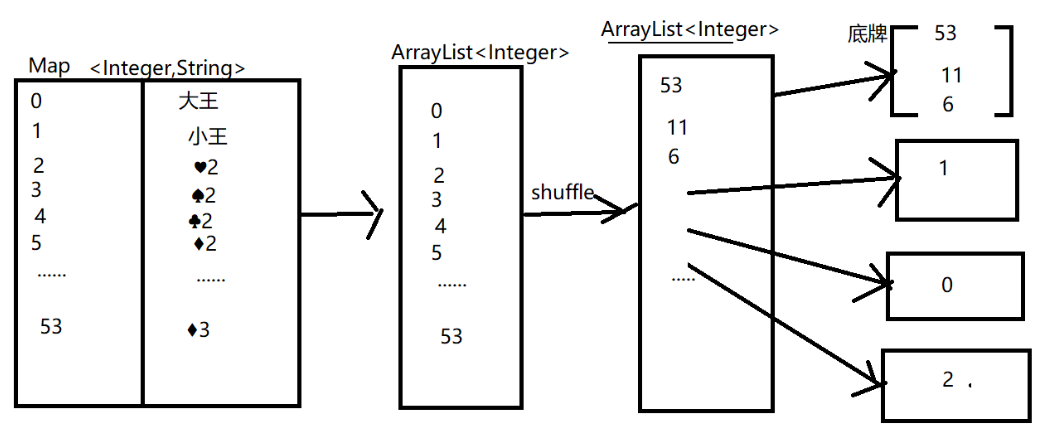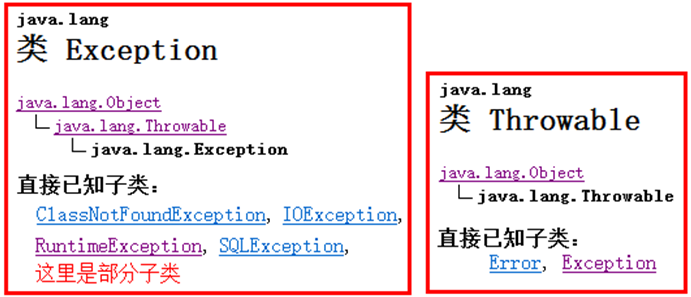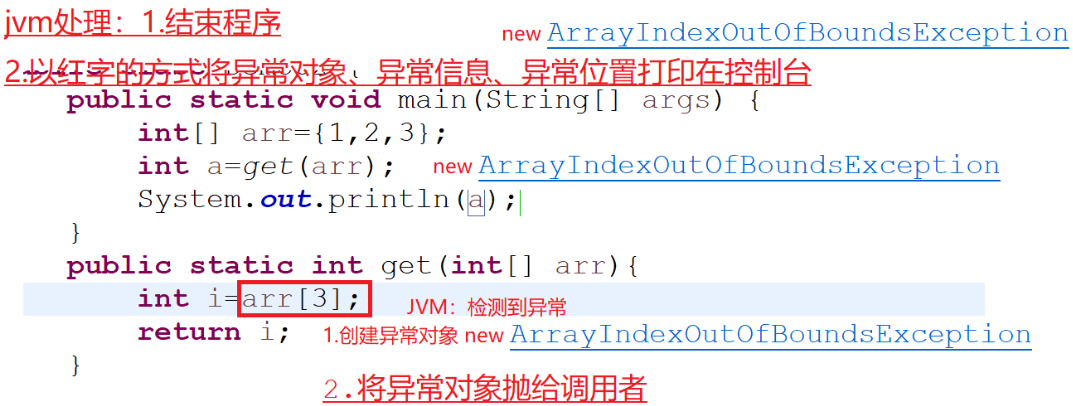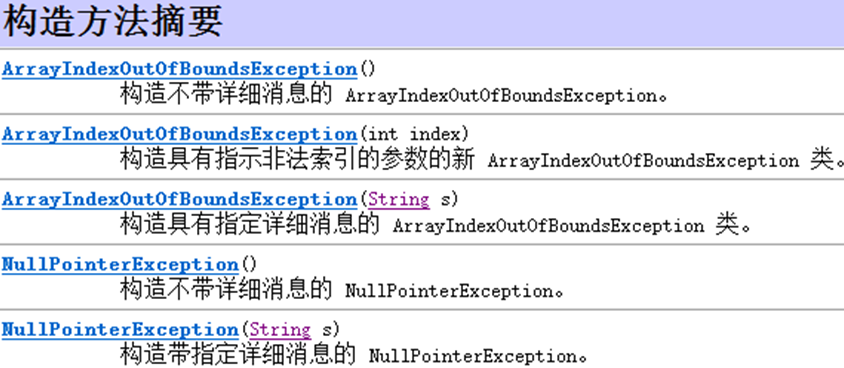模拟斗地主思路图

根据这个图来构思
package com.oracle.demo01; import java.util.ArrayList; import java.util.Collections; import java.util.HashMap; import java.util.Map; //模拟斗地主 public class DouDiZhu { public static void main(String[] args) { //1.创建扑克牌map Map<Integer,String> pooker=new HashMap<Integer,String>(); //创建所有key所在的容器 ArrayList<Integer> pookerNum=new ArrayList<Integer>(); //创建花色数组 String[] color={"黑桃","红桃","放屁","梅花"}; //创建牌号数组 String[] number={"2","A","K","Q","J","10","9","8","7","6","5","4","3"}; //造牌并存进map集合 int index=2; //先遍历数字 for(String n:number){ //在遍历花色 for(String c:color){ //向map中存数据 pooker.put(index,c+n); //向所有key所在的容器存数据 pookerNum.add(index); index++; } } //System.out.println(pooker); //把大王存进去 pooker.put(0,"大王"); pookerNum.add(0); //把小王存进去 pooker.put(1,"小王"); pookerNum.add(1); //用 collections洗牌 Collections.shuffle(pookerNum); System.out.println(pookerNum); //发牌 需要创建四个容器 ArrayList<Integer> bottom=new ArrayList<Integer>(); ArrayList<Integer> player1=new ArrayList<Integer>(); ArrayList<Integer> player2=new ArrayList<Integer>(); ArrayList<Integer> player3=new ArrayList<Integer>(); //发牌 用for循环遍历 for(int i=0;i<pookerNum.size();i++){ //将前三张牌给底牌 if(i<3){ bottom.add(pookerNum.get(i)); }else if(i%3==0){ player1.add(pookerNum.get(i)); }else if(i%3==1){ player2.add(pookerNum.get(i)); }else if(i%3==2){ player3.add(pookerNum.get(i)); } } //把三个玩家牌给排序:排的是4个容器的排序 Collections.sort(bottom); Collections.sort(player1); Collections.sort(player2); Collections.sort(player3); //看牌 look("刘德华",player1,pooker); look("渣渣辉",player2,pooker); look("阿斯蒂芬",player3,pooker); look("底牌",bottom,pooker); } //看牌的方法 传 玩家 字典 排 public static void look(String name,ArrayList<Integer> player,Map<Integer,String> pooker){ //打印玩家姓名 System.out.print(name+":"); //遍历所有牌号 增强for for(int num:player){ System.out.print(pooker.get(num)+" "); } System.out.println(); } }
异常
Java代码在运行时期发生的问题就是异常
异常的继承体系 Exception类来描述异常
Exception还有个兄弟 Error (错误)
区别:Exception能救 Error


异常继承体系总结:
Throwable:错误与异常的超类(祖宗类)
① Error 错误
② Exception 编译异常
2.1 RuntimeException 子类 运行异常
异常与错误的区别
异常:程序编译、运行期间发生的某种异常(XxxException),对异常进行具体的处理。若不处理,程序结束运行
错误:程序在运行期间发生了某种错误(XxxError),Error错误通常没有具体的处理方式,程序将会结束运行。Error错误是系统级别问题,都是jvm所在系统发生的,并反馈给jvm的。无法针对处理,只有改代码
异常的产生过程解析

| 异常类 | 说明 |
| ClassCastException | 类型转换异常 |
| ClassNotFoundException | 未找到相应类异常 |
| ArithmeticException | 算数异常 |
| ArrayIndexOutOfBoundsException | 数组下标越界异常 |
| ArrayStoreException | 数组中包含不兼容的值抛出异常 |
| SQLException | 操作数据库异常类 |
| NullPointerException | 空指针异常 |
| NoSuchFieldException | 字段未找到异常 |
| NoSuchMethodException | 方法未找到抛出的异常 |
| NumberFormatException | 字符串转数字抛出的异常 |
| NegativeArraySizeException | 数组元素个数为负数抛出异常 |
| StringIndexOutOfBoundsException | 字符串索引超出范围抛出异常 |
| IOException | 输入输出异常 |
| IllegalAccessException | 不允许访问某类异常 |
| InstantiationException | 应用程序试图使用Class类中的newInstance()方法创建一个类的实例,指定类对象无法被实例化 |
| EOFException | 文件结束 |
| FileNotFoundException | 文件未找到 |
| RuntimeException异常 | |
| 种类 | 说明 |
| NullPointerException | 空指针 |
| ArrayIndexOutOfBoundsException | 数组下标 |
| ArithmeticException | 算术 |
| ArrayStoreException | 数组中包含不兼容的值 |
| IllegalArgumentException | 非法参数 |
| SecurityException | 安全性 |
| NegativeArraySizeException | 数组长度为负 |
pm
抛出异常 throw
格式:throw new 异常类名(参数);

声明异常 throws
声明异常格式:修饰符 返回值类型 方法名(参数) throws 异常类名1,异常类名2...{}
package com.oracle.demo01; //抛出异常 throw 和 throws的用法 public class Throw { public static void main(String[] args) throws Exception{ //定义数组 int[] arr=null; //调用方法 int a=get(arr); System.out.println(a); } public static int get(int[] arr) throws Exception{ //如果arr为空 if(arr==null){ //抛出异常 throw new Exception("数组为空"); }
if(arr.length==0){
throw new Exception("数组长度为0"); //取下标 int i =arr[arr.length-1]; return i; } }
处理方式:
① 虚拟机处理 throws
② try...catch (自己处理的会显示 )

捕获异常try…catch…finally
捕获:Java中对异常有针对性的语句进行捕获,可以对出现的异常进行指定方式的处理
格式:
try {
//需要被检测的语句。
}
catch(异常类 变量) { //参数。
//异常的处理语句。
}
finally {
//一定会被执行的语句。
}
try:可能产生异常的代码。
catch:异常捕获,对捕获到的异常处理
finally:有无异常都要执行。如果因为异常导致程序跳转,有些代码无法执行,finally专治此问题,finally代码块的代码必须执行
class ExceptionDemo{ public static void main(String[] args){ //throws ArrayIndexOutOfBoundsException try { int[] arr = new int[3]; System.out.println( arr[5] );// 会抛出ArrayIndexOutOfBoundsException 当产生异常时,必须有处理方式。要么捕获,要么声明。 } catch (ArrayIndexOutOfBoundsException e) { //括号中需要定义什么呢?try中抛出的是什么异常,在括号中就定义什么异常类型。 System.out.println("异常发生了"); } finally { arr = null; //把数组指向null,通过垃圾回收器,进行内存垃圾的清除 } System.out.println("程序运行结果"); } }
try…catch…finally异常处理的组合方式
try catch finally组合:检测异常,并传递给catch处理,并在finally中进行资源释放
try catch组合 : 对代码进行异常检测,并对检测的异常传递给catch处理。对异常进行捕获处理
一个try 多个catch组合 : 对代码进行异常检测,并对检测的异常传递给catch处理。对每种异常信息进行不同的捕获处理
try finally 组合: 对代码进行异常检测,检测到异常后因为没有catch,所以一样会被默认jvm抛出。异常是没有捕获处理的。但是功能所开启资源需要进行关闭,所有finally。只为关闭资源
运行时期异常
RuntimeException和他的所有子类异常,都属于运行时期异常
NullPointerException,ArrayIndexOutOfBoundsException等都属于运行时期异常
特点:
①运行时期异常,方法定义中无需throws声明,调用者也无需处理此异常 ②运行期发生异常,改代码
异常在方法重写中细节
注意:
1 子类重写父类方法要抛出和父类一样的异常,要么不抛出
2 。。。。。。。。抛出的异常不能超过父类的范围(不能越界)
如果父类没抛 子类想抛 只能调try...catch
异常中常用方法

package com.oracle.demo01; //异常中常用方法 public class Throw3 { public static void main(String[] args) throws Exception{ //定义数组 int[] arr=null; //可能会发生异常的语句 try{ //调用方法 int a=get(arr); System.out.println(a); }catch(Exception ex){ //getMessage()只打印异常信息 //System.out.println(ex.getMessage());//不常用 //toString()打印异常对象和异常信息 //System.out.println(ex.toString()); //printStackTrace()以红字的方式打印异常对象、信息、位置 ex.printStackTrace(); }finally{ //不管发不发生异常都要执行的语句 System.out.println("finally执行了"); } } public static int get(int[] arr) throws NullPointerException,ArrayIndexOutOfBoundsException{ //如果arr为空 if(arr==null){ //抛出异常 throw new NullPointerException("数组为空"); } if(arr.length==0){ throw new ArrayIndexOutOfBoundsException("数组长度为0"); } //取下标 int i =arr[arr.length-1]; return i; } }
getMessage():返回该异常的详细信息字符串,即异常提示信息
toString():返回该异常的名称与详细信息字符串
printStackTrace():在控制台输出该异常的名称与详细信息字符串、异常出现的代码位置
自定义异常类的定义
格式
Class 异常名 extends Exception{ //或继承RuntimeException
public 异常名(){
}
public 异常名(String s){
super(s);
}
}
先确定RunTimeException时期还是非运行时期异常
package com.oracle.demo01; //自定义异常类 public class Zi定义异常类 { public static void main(String[] args) { //定义一个数组 int[] arr={7,8,9,4,5,6,-9}; double num=avg(arr); System.out.println(num); } //写一个方法求平均数 public static double avg(int[] arr){ //自已计数器 int sum=0; for(int i:arr){ //加个判断 if(i<0){ throw new FuShuException("负数异常"+i); } sum+=i; } //数组长度 return sum/arr.length; } } ----------------------------------------------------- package com.oracle.demo01; public class FuShuException extends RuntimeException{ public FuShuException(String s){ //传父类 super(s); } }